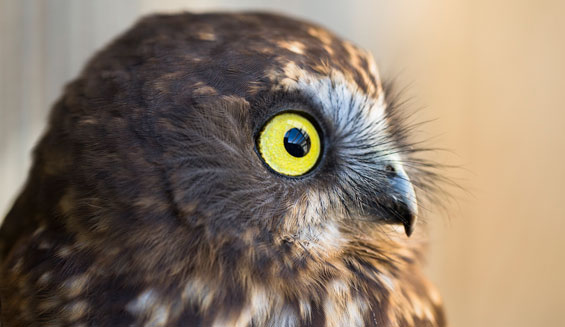Morepork/ruru
Introduction
The native morepork is known for its haunting, melancholic call. This sound gives it the Māori name 'ruru'.New Zealand status: Native
Conservation status: Not Threatened
Found in: Forests throughout mainland New Zealand and offshore islands
Threats: Predation, loss of habitat
Sound recordings:
Morepork/ruru song (MP3, 1,620K)
01:43 – Morepork/ruru song.
Species information: Morepork NZ Birds Online
Facts
Often heard in the forest at dusk and throughout the night, the morepork (Ninox novaeseelandiae) is known for its haunting, melancholic call. Its Māori name, ruru, reflects this call.
Distribution
Morepork are commonly found in forests throughout mainland New Zealand and on offshore islands.
They are less common within the drier open regions of Canterbury and Otago. They are classified as not threatened.
Features
Morepork are speckled brown with yellow eyes set in a dark facial mask. They have a short tail.
The females are bigger than the males. Head to tail they measure around 29 cm and the average weight is about 175 g.
They have acute hearing and are sensitive to light. They can turn their head through 270 degrees.

Morepork eating a huhu beetle

Often heard in the forest at dusk and throughout the night, the morepork is known for its haunting, melancholic call
Nocturnal birds of prey
Morepork are nocturnal, hunting at night for large invertebrates including beetles, weta, moths and spiders. They will also take small birds, rats and mice.
They fly silently as they have soft fringes on the edge of the wing feathers. They catch prey using large sharp talons or beak.
By day they roost in the cavities of trees or in thick vegetation. If they are visible during the day they can get mobbed by other birds and are forced to move.
Nesting and breeding
- Morepork nest in tree cavities, in clumps of epiphytes or among rocks and roots.
- The female can lay up to three eggs, but generally two, usually between September and November.
- The female alone incubates the eggs for about 20 to 30 days during which time the male brings in food for her.
- Once the chicks hatch, the female stays mainly on the nest until the owlets are fully feathered.
- They fledge around 37-42 days.
- Depending on food supply often only one chick survives and the other may be eaten.
Māori tradition
In Māori tradition the morepork was seen as a watchful guardian. It belonged to the spirit world as it is a bird of the night. Although the more-pork or ruru call was thought to be a good sign, the high pitched, piercing, ‘yelp’ call was thought to be an ominous forewarning of bad news or events.
Sound recording
Morepork/ruru song (MP3, 1,620K)
01:43 – Morepork/ruru song.
Our bird songs can be reused, even commercially, according to our copyright terms.
Threats
Predation and loss of habitat
Morepork are still considered to be relatively common but it is likely that numbers are in gradual decline due to predation and loss of habitat.
As the female is a hole-nester she is vulnerable to predators such as stoats and possums during the breeding season and eggs and chicks will also be at risk from rats.
Poisons
Morepork are possibly threatened from the use of toxins (particularly anti coagulants) used to reduce the numbers of predators. As morepork are at the top of the food chain they could be affected by an accumulative poison by eating live prey that has ingested poison.
Our work
Populations and pest management
DOC is involved in testing methods for measuring the population of morepork so that we can determine if they are increasing or decreasing in areas where pests are being managed.
Monitoring birds with transmitters
This involves putting transmitters on a number of birds in the Eglinton Valley and Waitutu to determine survival and mortality. Regular day and night-time monitoring of the transmitted birds will show where the territories are and give an indication of the actual numbers of birds.
A number of call counting methods will be completed over the area to determine what the relationship is between the number of calls and the number of birds. Improved technology and the use of automated recorders will help in this venture and will be tested in the near future.
You can help
- Keep old trees on your property so that morepork have nesting places.
- Plant new (preferably native) trees so that morepork will have places to nest in the future.
- Join the Wingspan Birds of Prey Trust.



